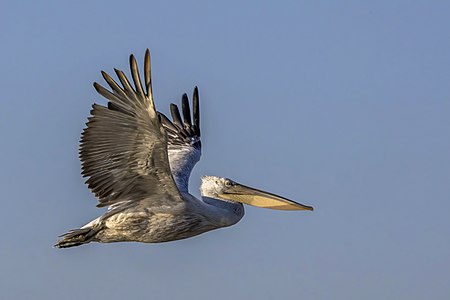Featured picture scheduled for POTD
Hello! This is to let editors know that File:Dalmatian pelican (Pelecanus crispus) in flight Danube delta 2.jpg, a featured picture used in this article, has been selected as the English Wikipedia's picture of the day (POTD) for November 7, 2024. A preview of the POTD is displayed below and can be edited at Template:POTD/2024-11-07. For the greater benefit of readers, any potential improvements or maintenance that could benefit the quality of this article should be done before its scheduled appearance on the Main Page. [Optional comments here.] If you have any concerns, please place a message at Wikipedia talk:Picture of the day. Thank you! ~~

|
|
The Dalmatian pelican (Pelecanus crispus) is a bird in the family Pelecanidae. With a length of 160 to 183 centimetres (63 to 72 inches), a mass of 7.25 to 15 kilograms (16.0 to 33.1 pounds) and a wingspan of 245 to 351 centimetres (96 to 138 inches), it is the largest pelican species and one of the world's largest living flying birds. The Dalmatian pelican has a range spanning across much of central Eurasia, from the Mediterranean in the west to the Taiwan Strait in the east, and from the Persian Gulf in the south to Siberia in the north. It is a short-to-medium-distance migrant between breeding and overwintering areas. The Dalmatian pelican's preferred habitat is lakes, rivers, deltas and estuaries, and it feeds on various fish species such as the common carp and European perch. Like many pelicans, it is often silent, but can be vocal during the mating season, engaging in a wide range of guttural, deep vocalisations, including barks, hisses and grunts. This Dalmatian pelican was photographed in flight over the Danube Delta in Romania. Photograph credit: Charles J. Sharp
Recently featured:
|
This template should always be substituted (i.e., use {{subst:UpcomingPOTD}}). |
Usage
This template can be used to notify editors of the article that serves as the boldfaced link in a POTD blurb by placing a message at the bottom of the corresponding article talk page. This is most easily done by employing the "New section" link at the top of the page and substituting the template using the code below, leaving the subject field blank since the template already generates a title. There are three unnamed parameters (two required, one optional) and two named parameters (both optional).
Example usage
- Blurb layout (default):
{{ subst:UpcomingPOTD | [File:]Example.png | 2024-11-07 [| Optional comments] [| display=blurb] }}- Thumbnail layout:
{{ subst:UpcomingPOTD | [File:]Example.png | 2024-11-07 [| Optional comments] | display=thumb [| size=200px] }}
- The first parameter (required) is the file name of the featured picture. The prefix
File:can either be included or omitted. If this is a multiple POTD (involving a random selection of more than one related image), providing the inputmultiplein place of a file name will generate a slightly different wording to reflect this. All featured pictures that form part of a multiple POTD should appear in the article in question. - The second parameter (required) is the date of the scheduled POTD appearance, which can be given in any valid format, but YYYY-MM-DD is preferred, as above.
- The third parameter (optional) provides a space for additional comments about the POTD selection. No text is added if the parameter is undefined or left blank.
- The parameter
|display=(optional) takes two possible values:blurb, which displays the standard layout of the POTD with the blurb as seen on the Main Page underneath the message, andthumb, which displays the POTD image as a thumbnail floating on the right with the article name as the caption. The blurb layout is displayed by default if this parameter is undefined.- The parameter
|size=(optional) can further be used to control the dimensions of the image in the thumbnail layout; if undefined, the default thumbnail size as set in the user preferences is used.
- The parameter
See also
- Template:NotifyPOTD (for user talk pages)